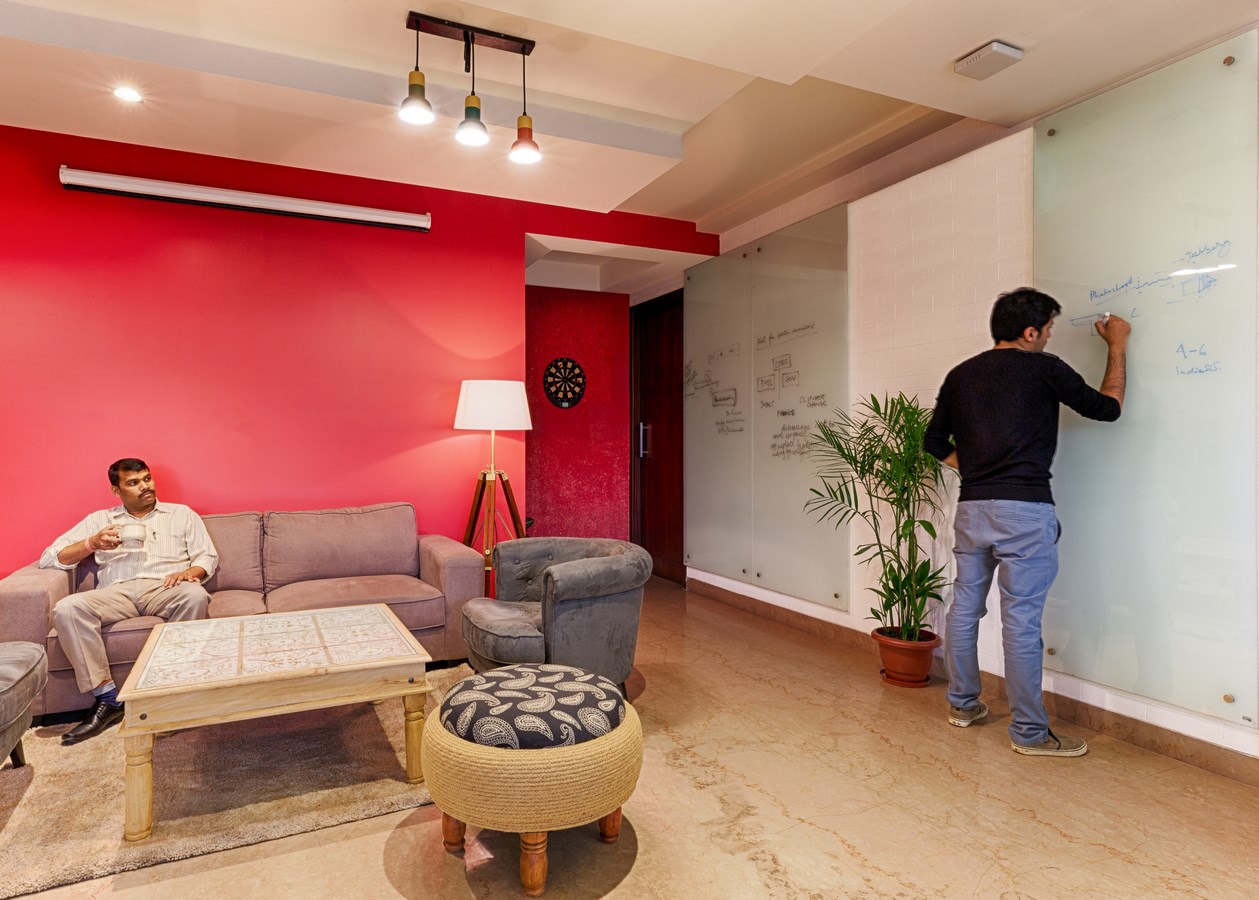“We are entrepreneurs and innovators, designers and creative problem solvers, thinkers, and doers.”- says Dalberg. These policy thinkers and advisors needed to have a working space in one of the high end areas of New Delhi, i.e., Panscheel Park. The area, once constructed as a 4BHK was to be transformed into a space serving the purpose of a workplace now. For this workplace, the main aspect to focus upon was the way they work, ideate and interact. The requirement was to have multiple avenues where these strategizers could cook up ideas instantly and pin them up whenever and wherever needed. It was essential to have flexible working conditions promoting communication so that they can work effectively. Therefore, Studio Bipolar envisioned a multifunctional space where the users can tag any idea as soon as it strikes them. The clients wanted to have a layout which could harness a flexible and creative working atmosphere while having individual’s privacy.
Architect’s Firm: Studio Bipolar
Website: www.studiobipolar.in

The space evolved with a relaxed organic ambience having quirky elements to bring breathable life to this space. The design nurtures a specific ethnic character to its elements and carries the brand colours. It follows the theme lying with the thought that Dalberg is a global think tank yet rooted in India deeply. They wanted it to be reflected in their décor.

The whole studio is divided into several spaces; a main work space, workspace cum meeting room, brainstorming room, conference room, break out zone and directors room among others.

As the users enter the office, one is greeted by an employee wall of fame at the right and a large expanse depicting Dalberg’s brand colour. It is a means for unification of the reception and main workspace, as it wraps around consecutive walls. The other side, we have a custom made frame housing a web of strings setup on the brand colours. It is a take on the fact that Dalberg works with NGOs and Indian craftsmen and artisans at the grass-root levels. It portrays the deep relationship they carry with the people ranging from a lower background to the highest governmental officials and focus on reducing the gaps and tying these sectors together. Another idea behind this string canopy was to create a quirky partition so as to shield the work space from reception space. This element metaphorically depicts Dalberg’s approach and adds a visual character to the space.

Moving further into the space, there is a breakaway area with projection facility and seating space for the office users which operates as a community space for the whole office. It serves as a relaxation zone for the staff with a provision for in-house movie nights to kick-start with the weekend.
The primary task to be accomplished was to make the main work space super functional. “We needed to maximize writeable surfaces for user convenience without spoiling their furniture. Thus, we came up with the idea to have an issuance for write up or pin up on the desks and glass partitions. We have provided glass inserts on desks and tag boards wherever possible so that they come in handy where employees can have discussions or while a group talk.”-Studio Bipolar.

This area also got furnished with a high table behaving as a break-out space for people to stand and discuss rather than sitting and thinking on their laptops. The neutral theme being maintained by the furniture was given a contrast by pop of green and red colours through plants and picture frames.
Coming to the conference room, the concept was to add a design character to the space without overwhelming the visitor and taking over the conversation. So they decided to add a String Canopy with pendant lights where the strings were tied to wooden battens. A large window towards the end of the room provides a view to the expanse of trees outside. The conference table was manufactured from solid teakwood planks joint together, supported by metal legs.

Moving on to the multifunctional workspace, it harbours four tables manufactured from solid pinewood. These four can be customized and configured according to the working conditions. They serve as four individual working desks when pulled apart as well as a single large joint conference table when required.

In the executive room, the work desks here are custom made and fabricated from solid pinewood so as to relate to an everlasting character and a classic look. A glass insert on the pinewood table top serves as a small surface for quick notes. This room was divided into two separate working cabins with a glass partition serving the purpose of an ideating surface. This surface not only provided privacy to the executives but also helped them collaborate in their serious discussions and added to a formal feel.

All in all, the designers made this office become effectively usable while highlighting the brand image and ideology in their elements. The overall workspace meets the needs of the users and helps them work efficiently.

Ujjwal Sagar and Sanjana Mathur
Studio bipolar was started in 2016. The partners Ujjwal Sagar and Sanjana Mathur were batchmates at Sushant school of art and architecture.
For Sanjana it was a natural entry into architecture being the daughter of architects (Rajat and Sushree Mathur, Fountainhead, they’re based in Delhi and they do a lot of infrastructure work like Metro stations JNU new campus etc, one of their accomplishments include the recently completed Magenta Metro Line in New Delhi), and the strong arts program at Vasant Valley School set the tone by honing her talents.
Ujjwal however, took a little longer to find his way. After school he signed up for a bachelor’s degree in physics at Delhi University. A year in, the need to do something more creative was strong, and he moved into architecture.
The New Delhi-based students met at Sushant School of Art and Architecture where, ‘studying under wonderful professors like Rajat Ray and Anurag Roy who encouraged us to look out into the world and really ponder the meaning of “space”, recollects Ujjwal, co founder, Studio Bipolar.
Sanjana interned at Anagram Architects under Vaibhav Dimri and Madhav Raman. ‘Working directly under them, I was really taught how to design. I worked directly under them during my internship, and was exposed to how they design, and what they look for in a space. The best thing about Vaibhav and Madhav is that they gave me a lot of freedom to experiment with my own ideas, which built my confidence, something that’s really important for young architects. Had heard about this methodology of theirs, which became my main reason for my internship.’
Ujjwal meanwhile did his initial training at Design and Development Atelier (DADA) in Gurgaon under Sumit Arora and Mukul Arora. ‘At DADA, they focused upon, and developed my core technical knowledge. Every day was like a masterclass in fusing great design with great functionality. Their meticulous approach and attention to the minutest detail made a great impression on me.’
He then moved to Anagram Architects where Ujjwal and Sanjana got numerous opportunities to work side by side on projects. Madhav and Vaibhav continue to be their architectural gurus. ‘Not only were they great bosses, it was their approach towards resolving their designs which truly inspire us. They gave us wonderful advice when we left, saying “There will never come a time when you go ‘Ah! Now I know everything!’ All you can do is keep learning everyday”. A unique quality we found was that they don’t have a set “style”. Each project is dramatically, visually and spatially, different from their previous works. They taught us that there is always a new solution to every problem. Since then neither of us have stopped wondering – can this be done better? does it have to be done only this way?’ commends Ujjwal.
When they felt confident, Sanjana and Ujjwal decided to branch out on their own – and Studio Bipolar was born in 2016. Initially it was just the two of them working out of a Chaayos, sda market coffee shop! But gradually a variety of projects entered their growing portfolio and they moved into their own office space, and started to grow their team.
“We chose to call ourselves Studio Bipolar because we think of ourselves as “polar opposites”. We like to think of our work as an amalgamation of opposing perspectives as both us have dissimilar, yes distinctive design aesthetics. Ujjwal loves ultra-modern, minimalist design with graphic elements. I tend to favour a more eclectic/natural look, with lots of exposed brick and earth tones. For our Hwealth Café, we chose to maintain a very simple palette of pinewood and rough white walls. Graphic tiles were added to give a “punch’ to the space, to energise it,’ details Sanjana, and adds laughingly, ‘as you can imagine, trying to work together on anything more often than not ends up in an argument!’
Since starting work in 2016, Studio Bipolar has been involved in various residential, commercial, f&B and office projects. “there is no one kind of project that defines us. We are designing a 15000 sqft classic European inspired chateau alongside an adaptive reuse project converting an abandoned factory warehouse into an office!”





